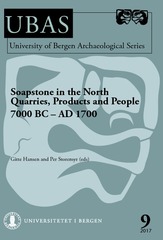From Numeric Data to Cultural History - A Typological and Chronological Analysis of Soapstone Vessels from the Medieval Bryggen Wharf in Bergen, Norway
Chapter, Peer reviewed
Published version
Permanent lenke
https://hdl.handle.net/1956/16590Utgivelsesdato
2017-08Metadata
Vis full innførselSamlinger
Sammendrag
This paper’s task is to establish a typology and a finer chronology of medieval Norwegian soapstone vessels used primarily as cooking pots. The case study includes 806 soapstone vessels from BRM 0 the Bryggen site located at Bryggen, the medieval wharf in Bergen, western Norway. The vessels stem from contexts dated from the 11th century to the 18th century. The assemblage is classified into six different vessel types: A–F. Soapstone vessels are frequent at Bryggen through to the end of the 15th century after which consumption drops off. A change from the relatively uniform western Norwegian A vessel type to a more diverse vessel design happens after the mid-1200s. It is suggested that the new diversity in shape points to a shift in the mode of production from a well-organised large production scale to a smaller one. Corresponding changes in the vessel assemblage points to an alteration in the way the vessels were used; the vessels cease to be produced in all sizes and generally get smaller and more homogenous in size in the later periods at Bryggen. As the vessels get smaller they are also more likely to have a flat or flattened bottom better suited to standing on a table to accommodate the new late medieval eating habits. German Hansa merchants occupied the Bryggen wharf from the 1360s, but the use of the indigenous soapstone cooking pots seems to continue to a certain degree.

